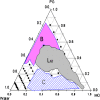Design and in vitro evaluation of capsaicin transdermal controlled release cubic phase gels
- PMID: 20839080
- PMCID: PMC2974133
- DOI: 10.1208/s12249-010-9481-1
Design and in vitro evaluation of capsaicin transdermal controlled release cubic phase gels
Abstract
The purpose of this study was to design and investigate the transdermal controlled release cubic phase gels containing capsaicin using glycerol monooleate (MO), propylene glycol (1,2-propanediol, PG), and water. Three types of cubic phase gels were designed based on the ternary phase diagram of the MO-PG-water system, and their internal structures were confirmed by polarizing light microscopy (PLM) and small-angle X-ray scattering (SAXS). Release results showed the cubic phase gels could provide a sustained system for capsaicin, while the initial water content in the gels was the major factor affecting the release rate. Release kinetics was determined to fit Higuchi's square-root equation indicating that the release was under diffusion control. The calculated diffusion exponent showed the release from cubic phase gels was anomalous transport. The unique structure of the cubic phases, capsaicin distributed in the lipid bilayers, and cubic phase gel swelling contributed to the release mechanism. The cubic phase gel may be an interesting application for transdermal delivery system of capsaicin in alleviating the post-incision pain.
Figures






Similar articles
-
Transdermal Cubic Phases of Metformin Hydrochloride: In Silico and in Vitro Studies of Delivery Mechanisms.Mol Pharm. 2018 Aug 6;15(8):3121-3132. doi: 10.1021/acs.molpharmaceut.8b00209. Epub 2018 Jul 24. Mol Pharm. 2018. PMID: 29979604
-
Characterization of cubosomes as a targeted and sustained transdermal delivery system for capsaicin.Drug Des Devel Ther. 2015 Aug 3;9:4209-18. doi: 10.2147/DDDT.S86370. eCollection 2015. Drug Des Devel Ther. 2015. PMID: 26345516 Free PMC article.
-
Cubic Liquid Crystalline Gels Based on Glycerol Monooleate for Intra-articular Injection.AAPS PharmSciTech. 2018 Feb;19(2):858-865. doi: 10.1208/s12249-017-0894-y. Epub 2017 Oct 12. AAPS PharmSciTech. 2018. PMID: 29027137
-
Cubic phase gels as drug delivery systems.Adv Drug Deliv Rev. 2001 Apr 25;47(2-3):229-50. doi: 10.1016/s0169-409x(01)00108-9. Adv Drug Deliv Rev. 2001. PMID: 11311994 Review.
-
Qutenza®: a capsaicin 8% patch for the management of postherpetic neuralgia.Expert Rev Neurother. 2011 Jan;11(1):15-27. doi: 10.1586/ern.10.182. Expert Rev Neurother. 2011. PMID: 21158551 Review.
Cited by
-
Transdermal metformin hydrochloride-loaded cubic phases: in silico formulation optimization, preparation, properties, and application for local treatment of melanoma.Drug Deliv. 2019 Dec;26(1):376-383. doi: 10.1080/10717544.2019.1587046. Drug Deliv. 2019. PMID: 30905216 Free PMC article.
-
The Influence of Hydrophobic Blocks of PEO-Containing Copolymers on Glyceryl Monooleate Lyotropic Liquid Crystalline Nanoparticles for Drug Delivery.Polymers (Basel). 2021 Aug 5;13(16):2607. doi: 10.3390/polym13162607. Polymers (Basel). 2021. PMID: 34451146 Free PMC article.
-
Development of a HPLC Method for the Quantitative Determination of Capsaicin in Collagen Sponge.Int J Anal Chem. 2015;2015:912631. doi: 10.1155/2015/912631. Epub 2015 Nov 3. Int J Anal Chem. 2015. PMID: 26612986 Free PMC article.
-
Transdermal Delivery of Capsaicin Nanoemulgel: Optimization, Skin Permeation and In Vivo Activity against Diabetic Neuropathy.Adv Pharm Bull. 2022 Aug;12(4):780-790. doi: 10.34172/apb.2022.080. Epub 2021 Oct 9. Adv Pharm Bull. 2022. PMID: 36415631 Free PMC article.
-
Development and optimization of nanoparticles loaded with erucin, a dietary isothiocyanate isolated from Eruca sativa: Antioxidant and antiproliferative activities in ehrlich-ascites carcinoma cell line.Front Pharmacol. 2023 Jan 25;13:1080977. doi: 10.3389/fphar.2022.1080977. eCollection 2022. Front Pharmacol. 2023. PMID: 36761468 Free PMC article.
References
-
- Fusco B, Giacovazzo M. Peppers and pain: the promise of capsaicin. Drugs (Basel) 1997;53(6):909–914. - PubMed
-
- Hayman M, Kam PCA. Capsaicin: a review of its pharmacology and clinical applications. Curr Anaesth Crit Care. 2008;19(5–6):338–343.
Publication types
MeSH terms
Substances
LinkOut - more resources
Full Text Sources
Other Literature Sources

